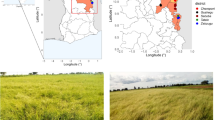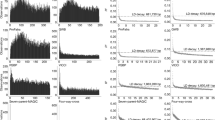Abstract
In South America, native maize germplasm has been extensively studied particularly for the Andean region. However, relatively few genetic diversity studies include materials from the eastern region of the continent. Herein we present a genetic diversity characterization of four Popcorn maize landraces, maintained in indigenous settlements, from Northeastern Argentina (NEA). In addition, one Popcorn landrace from Northwestern Argentina (NWA) was incorporated for comparison. We characterized these landraces using ten microsatellite markers. For the whole data set, a total of 65 alleles were found, with an average of 7.22 alleles per locus. The average gene diversity was 0.370. Global fit to Hardy–Weinberg proportions was observed in all landraces. Global estimates of F ST revealed a significant differentiation among the populations. Individual Neighbor-joining clustering and Bayesian analyses allowed the recognition of most populations studied. Two main groups were distinguished by the Neighbor-joining clustering of populations. This grouping pattern would be consistent with a hypothesis of successive introductions of Popcorn in South America. The results presented will be useful to design strategies that maximize the utility of maize genetic resources.




Similar content being viewed by others
References
Barnaud A, Deu M, Garine E, McKey D, Joly HI (2007) Local genetic diversity of sorghum in a village in Northern Cameroon: structure and dynamics of landraces. Theor Appl Genet 114:237–248
Bassam BJ, Caetano-Anollés G, Greshoff PM (1991) Fast and sensitive silver staining of DNA in polyacrylamide gels. Anal Biochem 196:81–84
Camus-Kulandaivelu L, Veyrieras JB, Gouesnard B, Charcosset A, Manicacci D (2007) Evaluating the reliability of structure outputs in case of relatedness between individuals. Crop Sci 47:887–892
Carvalho VP, Ruas CF, Ferreira JM, Moreira RMP, Rusas PM (2004) Genetic diversity among maize (Zea mays L.) landraces assessed by RAPD markers. Genet Mol Biol 27(2):228–236
Dellaporta IK, Wood J, Hicks JB (1983) A plant DNA minipreparation: version II. Plant Mol Biol Rep 1:19–21
Doebley J (1990) Molecular evidence and the evolution of maize. Econ Bot 44:7–25
El Mousadik A, Petit R (1996) High level of genetic differentiation for allelic richness among populations of the argan tree (Argania spinosa (L.) Skeels) endemic to Morocco. Theor Appl Genet 92:832–839
Felsenstein J (1991–2004) Phylip (Phylogeny inference package). University of Washington, Washington
Gaggiotti OE, Lange O, Rassmann K, Gliddon C (1999) A comparison of two indirect methods for estimating average levels of gene flow using microsatellite data. Mol Ecol 8:1513–1520
Goodman MM, McK. Bird R (1977) The races of maize iv: tentative grouping of 219 Latin American races. Econ Bot 31:204–221
Goodman MM, Stuber CW (1983) Races of maize. VI. Isozyme variation among races of maize in Bolivia. Maydica 28:169–187
Goudet J (2001) FSTAT, a program to estimate and test gene diversities and fixation indices (version 2.9.3). Available from http://www.unil.ch/izea/softwares/fstat.html. Updated from Goudet (1995) FSTAT version 1.2: a computer program to calculate F-statistics. J Hered 86:485–486
Hardy OJ, Charbonnel N, Freville H, Heuertz M (2003) Microsatellite allele sizes: a simple test to assess their significance on genetic differentiation. Genetics 163:1467–1482
Kimura M, Crow JF (1964) The number of alleles that can be maintained in a finite population. Genetics 49:725–738
Kimura M, Ohta T (1978) Stepwise mutation model and distribution of allelic frequencies in finite populations. Proc Natl Acad Sci 75:2868–2872
Latournerie Moreno L, Tuxill J, Yupit Moo E, Arias Reye L, Alejo JC, Jarvis DI (2006) Traditional maize storage methods of Mayan farmers in Yucatan, Mexico: implications for seed selection and crop diversity. Biodivers Conserv 15:1771–1795
Lia VV (2004) Diversidad genética y estructura poblacional en razas nativas de maíz (Zea mays ssp. mays) del Noroeste Argentino: presente y pasado del germoplasma autóctono. Doctoral Thesis, Facultad de Ciencias Exactas y Naturales, Universidad de Buenos Aires, Buenos Aires, 193 pp
Lia VV, Confalonieri VA, Ratto N, Cámara Hernández JA, Miante Alzogaray AM, Poggio L, Brown TA (2007a) Microsatellite typing of ancient maize: insights into the history of agriculture in southern South America. Proc R Soc B 274:545–554
Lia VV, Bracco M, Gottlieb AM, Poggio L, Confalonieri VA (2007b) Complex mutational patterns and size homoplasy at maize microsatellite loci. Theor Appl Genet 115:981–991
Liu K, Goodman M, Muse S, Smith JS, Buckler E (2003) Genetic structure and diversity among maize inbred lines as inferred from DNA microsatellites. Genetics 165:2117–2128
Matsuoka Y, Vigouroux Y, Goodman MM, Sánchez GJ, Buckler ES, Doebley JF (2002a) A single domestication for maize shown by multilocus microsatellite genotyping. Proc Natl Acad Sci 99:6080–6084
Matsuoka Y, Mitchell SE, Kresovich S, Goodman MM, Doebley JF (2002b) Microsatellites in Zea - variability, patterns of mutations, and use for evolutionary studies. Theor Appl Genet 104:436–450
McClintock B, Kato TA, Blumenschein A (1981) Chromosome constitution of the races of maize. Its significance in the interpretation of relationships between races and varieties in the Americas. Colegio de Postgraduados Chapingo, México, pp 125–173
Minch E, Ruiz Linares A, Goldstein D, Feldman M, Cavalli-Sforza LL (1995–1996) Microsat (version 1.5b): a computer program for calculating various statistics on microsatellite allele data. Available at http://www.btkastanfordedu/microsat.html
Nei M (1972) Genetic distance between populations. Am Nat 106:283–292
Nei M (1987) Molecular evolutionary genetics. Columbia University Press, New York
Nybom H (2004) Comparison of different nuclear DNA markers for estimating intraspecific genetic diversity in plants. Mol Ecol 13:1143–1155
Oliveira Freitas F, Bendel G, Allaby RG, Brown T (2003) DNA from primitive maize landraces and archaeological remains: implications for the domestication of maize and its expansion into South America. J Archaeol Sci 30:901–908
Page RDM (1996) TREEVIEW: an application to display phylogenetic trees on personal computers. Comput Appl Biosci 12:357–358
Peakall R, Smouse PE (2006) GENALEX 6: genetic analysis in Excel. Population genetic software for teaching and research. Mol Ecol Notes 6:288–295
Perales RH, Brush SB, Qualset CO (2003) Landraces of maize in Central Mexico: an altitudinal transect. Econ Bot 57:7–20
Piperno DR, Flannery KV (2001) The earliest archaeological maize (Zea mays L.) from highland Mexico: new accelerator mass spectrometry dates and their implications. Proc Natl Acad Sci 98:2101–2103
Piperno DR, Pearsall DM (1998) The origins of agriculture in the lowland neotropics. Academic Press, San Diego
Pressoir G, Berthaud J (2004a) Population structure and strong divergent selection shape phenotypic diversification in maize landraces. Heredity 92:95–101
Pressoir G, Berthaud J (2004b) Patterns of population structure in maize landraces from the Central Valleys of Oaxaca in Mexico. Heredity 92:88–94
Pritchard JK, Stephens M, Donnelly P (2000) Inference of population structure using multilocus genotype data. Genetics 155:945–959
Raymond M, Rousset F (1995) Genepop (version 1.2): Population genetics software for exact tests and ecumenicism. J Hered 86:248–249
Reif JC, Warburton ML, Xia XC, Hoisington DA, Crossa J, Taba S, Muminovic J, Bohn M, Frisch M, Melchinger AE (2006) Grouping of accessions of Mexican races of maize revisited with SSR markers. Theor Appl Genet 113:177–185
Rice W (1989) Analysing tables of statistical tests. Evolution 43:223–225
Saitou N, Nei M (1987) The neighbor-joining method: a new method for reconstructing phylogenetic trees. Mol Biol Evol 4:406–425
Sánchez GJ, Stuber JCW, Goodman MM (2000) Isozymatic diversity in the races of maize of the Americas. Maydica 45:185–203
Santacruz-Varela A, Widrlechner MP, Ziegler KE, Salvador RJ, Millard MJ, Bretting PK (2004) Phylogenetic relationships among North American popcorns and their evolutionary links to Mexican and South American popcorns. Crop Sci 44:1456–1467
Senior ML, Murphy JP, Goodman MM, Stuber CW (1998) Utility of SSRs for determining genetic similarities and relationships in maize using an agarose gel system. Crop Sci 38:1088–1098
Slatkin M (1995) A measure of population subdivision based on microsatellite allele frequencies. Genetics 139:457–462
Vigouroux Y, Jaqueth JS, Matsuoka Y, Smith OS, Beavis WD, Smith JSC, Doebley J (2002) Rate and pattern of mutation at microsatellite loci in maize. Mol Biol Evol 19:1251–1260
Weir B, Cockerham CC (1984) Estimating F-statistics for the analysis of population structure. Evolution 38:1358–1370
Wright S (1978) Variability within and among natural populations in evolution and the genetics of populations. University of Chicago Press, Chicago
Xia XC, Reif JC, Hoisington DA, Melchinger AE, Frisch M, Warburton ML (2004) Genetic diversity among CIMMYT maize inbred lines investigated with SSR markers: I. Lowland tropical maize. Crop Sci 44:2230–2237
Xia XC, Reif JC, Melchinger AE, Frisch M, Hoisington DA, Beck D, Pixley K, Warburton ML (2005) Genetic diversity among CIMMYT maize inbred lines investigated with SSR markers: II. Subtropical, tropical midaltitude, and highland maize inbred lines and their relationships with elite U.S. and European maize. Crop Sci 45:2573–2582
Acknowledgements
We thank Ing. Héctor Keller for driving us to the indigenous settlements and for his kind assistance during the collecting trip. We are grateful to the “Guaraní” communities for providing us the landraces included in this study. We are in debt to two anonymous reviewers who have greatly improved this manuscript; to Dr. Letizia Camus-Kulandaivelu and Dr. Domenica Manicacci for providing the software for the STRUCTURE stability analysis and for their helpful comments; and to Leandro Citate for his contributions with C-language programs. Several grants from the Consejo Nacional de Investigaciones Científicas y Técnicas (PIP 5927), the Universidad de Buenos Aires (EX-317) and the Agencia Nacional de Promoción Científica y Tecnológica (BID 1728 OC-AR PICT 14119 and 14170) are gratefully acknowledged.
Author information
Authors and Affiliations
Corresponding author
Rights and permissions
About this article
Cite this article
Bracco, M., Lia, V.V., Gottlieb, A.M. et al. Genetic diversity in maize landraces from indigenous settlements of Northeastern Argentina. Genetica 135, 39–49 (2009). https://doi.org/10.1007/s10709-008-9252-z
Received:
Accepted:
Published:
Issue Date:
DOI: https://doi.org/10.1007/s10709-008-9252-z




